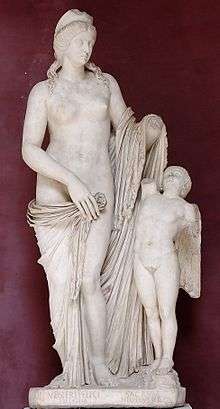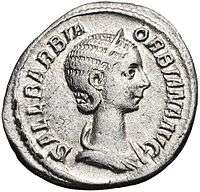Sallustia Orbiana

Seia Herennia Sallustia Barbia Orbiana Augusta (fl. 220s), also known as Barbia Orbiana, was an Augusta of the Roman Empire and briefly the wife of Emperor Severus Alexander. She was known for her beauty, which was captured in multiple works of art. Following the execution of her father Seius Sallustius, she was exiled to North Africa, after only two years as empress.
Augusta

Orbiana was born to influential Roman Senator Seius Sallustius in the early third century CE. In August 225,[1] at about the age of 16 years,[2] she wed Roman Emperor Severus Alexander in an arrangement organized by the emperor's mother, Julia Mamaea.[3] After Orbiana was given the title of Augusta, Mamaea grew jealous, due to her desire for complete ownership of all feminine imperial titles, and the strong bond that developed between Orbiana and Severus.[2] She treated Orbiana cruelly, forcing her to seek refuge with her father, Sallustius, who is believed to had been appointed as a Caesar.[2] Sallustius consulted with the Praetorian Guard for protection of Orbiana, but the act was determined to be treasonous.[2] In August 227,[1] Sallustius was executed, and Orbiana was stripped of her title, divorced and exiled to the province of Libya in North Africa. Severus Alexander had the power to intervene, but chose not to. He and his mother later died during the usurpation by Maximinus Thrax in 235, ending the Severan dynasty.[4]
Depictions

A notable statue of Orbiana, represented as Venus Felix, was unearthed near the church of Santa Croce in Gerusalemme. The marble, now in the Cortile Belvedere of the Vatican Museums, was dedicated the empress by her liberti, Helpidius and Sallustia.[5] Besides a limited emission of coinage in bronze and silver, several Roman gold coins were minted with Orbiana's visage, including a coin which sold for £26.00 in 1897. She was the only wife of Severus to be featured on coins.[4]
Cultural references
Sallustia Orbiana is a character in Alessandro Severo (1716), an opera seria libretto by Apostolo Zeno. This was later adapted as La Salustia (1732), set to music by Giovanni Battista Pergolesi.
Notes
- 1 2 Hopkins, Sir Richard Valentine Nind (1907). The life of Severus Alexander. The University press. pp. 57–58. Retrieved 27 August 2010.
- 1 2 3 4 Vagi, David L. (2000). Coinage and history of the Roman Empire, c. 82 B.C.- A.D. 480: Coinage. Taylor & Francis. pp. 308–309. ISBN 978-1-57958-316-3. Retrieved 27 August 2010.
- ↑ Kean, Roger Michael; Frey, Oliver (2005-10-20). The complete chronicle of the emperors of Rome. Thalamus.
- 1 2
- Sallustia Barbia Orbiana a site devoted to Orbiana
- ↑ Lanciani, Rodolfo, Wandering Through Ancient Roman Churches, [1924], Kessinger Publishing 2003, ISBN 0-7661-3525-X, pp. 217, 219; Museo Vaticano, 1846, p. 25.
References
External links
| Wikimedia Commons has media related to Sallustia Orbiana. |
| Royal titles | ||
|---|---|---|
| Preceded by Aquilia Severa |
Empress of Rome 225–227 |
Succeeded by Caecilia Paulina |